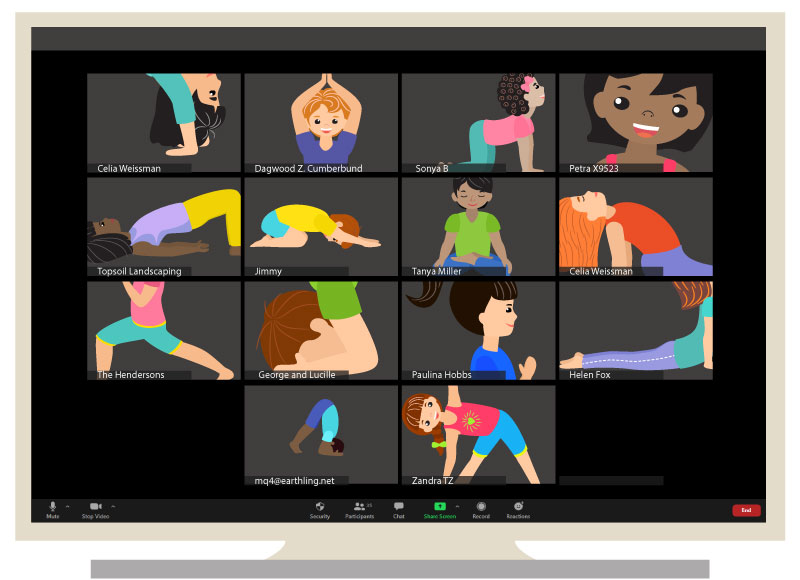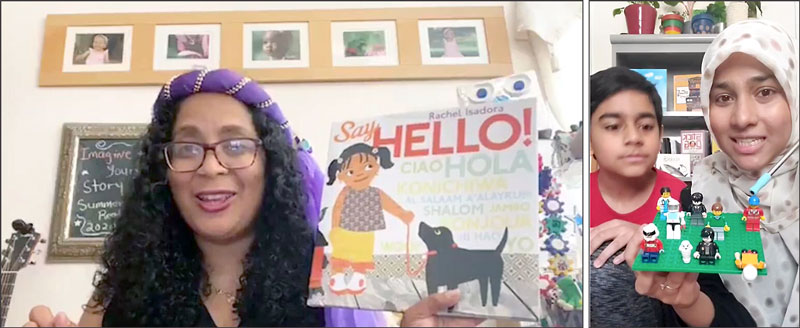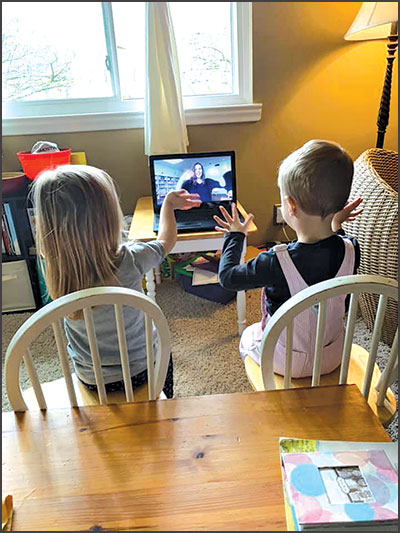Screen Time to the Rescue! Virtual Early Learning
Created out of necessity, virtual library programs for little ones and their families, who tune in from home, have many upsides.
 |
SLJ montage, characters by luplupme/Getty Images |
 |
lostinbids/Getty Images |
After libraries shut down in response to the novel coronavirus pandemic, early learning programs went virtual, offering story times, crafts, and dance lessons to eager families. It was an emergency tactic, but the programs have been so well received, librarians say, that many will continue in some form as libraries open for patrons. Some are offered to the general public beyond the library community on platforms including YouTube and Facebook Live. The programs often adopt strategies more typical of kids’ TV than library reading areas—and can draw thousands more attendees.
Among those who pivoted instantly to virtual playtime was Kristin Grabarek, who launched the weekly Little University program at Denver Public Library (DPL) almost six years ago. The play element is key, Grabarek says, and so is offering activities parents and children can do together.
Since March, the library’s play-based 0–5 program has offered ballet, yoga, and other activities via Zoom, in addition to three live story times—with Spanish language, toddler, and preschool options—weekdays on YouTube.
Lisa Dengerink, DPL early learning librarian who is overseeing all 0–5 virtual programming, helped rush to get the Little University program and virtual story times set up as soon as they knew the library would be closing. “As a parent myself, I knew parents were just like, ‘Oh my gosh, what am I going to do? I need things for my kids to do.’”
 |
From left: The Dollhouse Thieves musical duo perform live from their couch for Denver Public Library programming; Kat Savage hosts a pride-themed story time from home for Brooklyn Public Library’s virtual story time.Courtesy of Dollhouse Thieves; courtesy of Brooklyn Public Library |
Rising attendance
By the numbers, Dengerink says DPL’s online programs receive between 50 and 100 views the first day and 3,000 total per week, compared to an average 1,000 participants per week at the branches’ in-person story times. Many families have multiple kids watching virtual story times simultaneously, increasing views even more.
Local arts groups have continued to participate in Little University, including the Colorado Ballet, whose presenter conducted a class from home. “It’s a really fun, basic dance class for kids and introduces them to a lot of really cool things related to ballet,” Dengerink says. Local band the Dollhouse Thieves, a husband-and-wife team, logged into the library’s YouTube Live site from home and performed from their living room couch with help from their one-year-old.
The Chattanooga (TN) Public Library (CPL) has gotten a positive response from the online programs—including from people living far away. “We’ve had comments from people who are now followers of ours from other states: ‘Thank you so much for doing this, we really miss our programs at home,’” says Lee Hope, head of children’s services. Parents have even sent photos of their kids watching the programs.
Normally, CPL offers two or three Baby Bounce programs weekly at each location, plus two or three weekly Toddler Times, and a preschool story time. It all went online after the library closed on March 14, “so that we have a program virtually every day for kids ages 0–5,” says Hope. Posted on Facebook and Instagram, the programs happen at their regular times; a Bedtime Story also streams on Fridays.
Normally, the library would provide craft materials, but “since that’s not an option, we’re giving [parents ideas for] things they can do at home,” Hope says. A recent Bedtime Story craft involved making a sign for the door saying, “Please don’t disturb, I’m sleeping” on one side and “Please don’t disturb, I’m reading” on the other.
The same four staffers from different branches are hosting these virtual programs “so that the kids can see their librarians from home and recognize them,” Hope says. Bedtime Stories feature read-alouds from people in the community, including actor Leslie Jordan, who recorded three different videos for the library. The videos, which aired on Facebook Live and expired after a certain amount of time, gained the library many more followers, Hope says.
In addition to a larger audience, Brooklyn Public Library (BPL) has seen more staff engagement in virtual programming. After BPL moved its core story time programs online, including Babies and Books, Toddler Time, and Story and Play, librarians volunteered to continue these programs virtually through Facebook Live, signing up for scheduled time slots every week. “It’s getting clearer to our staff that this might be the way things are going to go for a while, so we’ve had way more engagement from a wider and more diverse group of our staff,” says Jessica Ralli, coordinator of early literacy programs. Story times are offered in Spanish, Arabic, Cantonese, and Mandarin, and BPL is planning to host them in at least six more languages.
Ralli and BPL staff weren’t sure how Brainy Babies, a grant-funded program that supports new parents or parents of young children in vulnerable housing situations or low-income neighborhoods, would work online. It’s normally held in English and Spanish at one branch, and in English with an ASL interpreter at another, and the goal is to help parents learn about community resources and connect with one another. But switching it to Zoom has been surprisingly successful, Ralli says, drawing about 35 babies and toddlers and their parents per session. Playtime now works more like a show-and-tell, while parents and facilitators share ways to engage the kids at home.
Denver’s Spanish story times are popular with both English- and Spanish-speaking families; some parents of English-speaking children say they tune in to help their kids learn Spanish.
Grabarek has learned a lot from watching her own children engage with the live presentations. “It’s much more of a question-answer and open dialogue,” she says. “Even though of course the person is not actually there able to hear my children, [the kids] interact as though the provider is able to. So it’s very different from a standard screen-time experience where they’re kind of sitting and watching.”
Other library systems have asked how to replicate what DPL is doing, Grabarek adds.
The virtual BPL story times average between 500 and 3,000 views, according to Ralli. “It’s made our sleepy Facebook page way less sleepy.” Previously, any post from the library would get six or seven views. But back then, BPL also had 60 live story times across the branches, as opposed to the two or three a day online.
 |
From the left: Juana Flores sharing a multilingual book during a BPL virtual storytime; Shamsa Chaudhri holds a storytime in Urdu and talks about the 2020 Census.Courtesy of Brooklyn Public Library |
New engagement strategies
Staffers are learning the process as they go, even those who aren’t tech experts, Ralli says. “Nobody is too worried about making mistakes. It’s definitely been a steep learning curve.” The Brainy Babies facilitators who had never used Zoom before are now regularly “cohosting a Zoom with 35 babies and toddlers.”
The library’s IT department makes sure presenters have laptops or tablets with an internet connection, while the marketing department created a guide on how to do virtual programming, “with some dos and don’ts, and best practices about where to put the camera, and lighting, and eye level, and things like that.”
BPL closed on March 15, and the first virtual story time was on the 16th, drawing on lessons from the one test video they’d been able to do before the shutdown. That gave staff a sense of how long a video should be, what to say, and what resources to highlight, she says.
The guide suggests a welcome song or other ritual, reading two to three books mixed in with songs, plus an optional craft or movement activity. “Some of [the presenters] have done mindfulness or yoga demonstrations towards the end. Some have demonstrated a simple science activity,” Ralli says. While one librarian leads the session, another volunteer monitors the comments, answers parents’ questions, or adds links, such as to the lyrics for a song they’re singing or to an ebook.
At DPL, Dengerink says that about 35 people in a three-week rotation are filming 15 story times a week. With supervisor approval, librarians entered the library for 15 minutes when the library first closed to pull titles from their story time collection. They went back for more materials at the end of May, she says.
Mindful of copyright issues over the music and books they use, librarians say they remove the videos after a set amount of time. At CPL, Hope says, staff gets permission from publishers for the books they use. “Just in case somebody can’t be right in front of the screen at 10 o’clock on a Monday, we like to leave the videos up for the amount of time the publishers allow it,” she says; in some cases, that’s 30 days.
Whether or not they know of families lacking internet access, the libraries are keeping their wireless network available so people can bring their device to the parking lot during library hours.
It’s still important for young children to have balanced days, Ralli says. BPL is working on a series of early learning blog posts called Tech Play Recipes, offering parents suggestions for activities to do using basic technology from home.
Grabarek, though, thinks virtual programs should be considered “face time,” per the adjusted American Academy of Pediatrics guidelines, because of the interaction (according to the AAP, going online for educational activities or social connection is fine, as long as it’s balanced with off-line activity).
 |
Tuning in to a Chattanooga (TN) Public Library early learning event.Patron-submitted photo courtesy of Chattanooga Public Library |
The long run
As part of its summer program, CPL will post nature-related challenges such as a scavenger hunt, Hope says. “We have had so much tremendous support from the community and excitement from the community [for the virtual programming] that I don’t think our program is ever going to look the same.”
At DPL, Grabarek says she’s watched the program shrink, losing some attendees, and then expand further by gaining an even wider audience. “Now anybody in Denver with the link to the program can access it,” far beyond those who live in neighborhoods where branch programs were offered.
Families hadn’t always been able to get to BPL’s Brainy Babies in person, Ralli says, because of older siblings’ activities, bad weather, or because the family relocated. “They’ve actually rejoined the virtual version of the program and get to see all of the friends and connections that they made,” she says.
That shows how something good can come out of this terrible time, she says, noting that online programs “could be a way of increasing access to programming and doing outreach in a way that we hadn’t really thought of doing before.”
“There’s a lot of reasons to keep going with it,” Dengerink adds. Parents say the story times bring a piece of their daily routine back into their lives. “That part has been really powerful for us, to just know that this one little piece of normalcy has helped the kids and their parents during this time.”
It helps the staff, too, according to Dengerink. They say, “This is my one normal thing that I get to continue to do.”
 Marlaina Cockcroft is a freelance writer and editor.
Marlaina Cockcroft is a freelance writer and editor.
RELATED
The job outlook in 2030: Librarians will be in demand
The job outlook in 2030: Librarians will be in demand
ALREADY A SUBSCRIBER? LOG IN
We are currently offering this content for free. Sign up now to activate your personal profile, where you can save articles for future viewing





Add Comment :-
Be the first reader to comment.
Comment Policy:
Comment should not be empty !!!